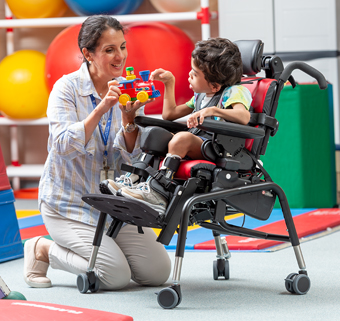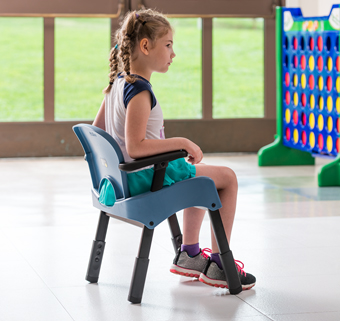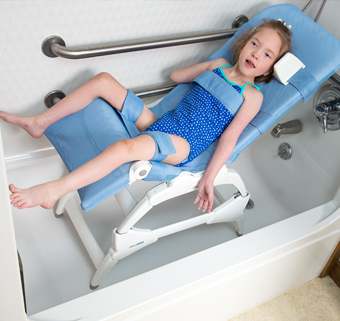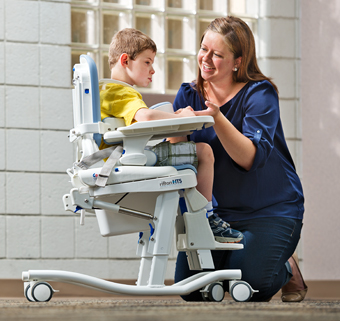 As school-based therapists, we are frequently asked to provide input on seating, standing, and movement opportunities (including walking and gross motor participation). The school is a naturally supportive setting for children of all abilities to participate more. Also, positioning plays an important role in learning. This article focuses on improving the success of children with medical complexity (CMC) in the classroom and beyond. Children with medical complexity are defined as having high health care needs, one or more chronic conditions, and often require medical technology and significant environmental modifications (Cohen, 2011). Typically children in this category are functioning at Gross Motor Functioning Classification System (GMFCS) level IV or V (CanChild).
As school-based therapists, we are frequently asked to provide input on seating, standing, and movement opportunities (including walking and gross motor participation). The school is a naturally supportive setting for children of all abilities to participate more. Also, positioning plays an important role in learning. This article focuses on improving the success of children with medical complexity (CMC) in the classroom and beyond. Children with medical complexity are defined as having high health care needs, one or more chronic conditions, and often require medical technology and significant environmental modifications (Cohen, 2011). Typically children in this category are functioning at Gross Motor Functioning Classification System (GMFCS) level IV or V (CanChild).
Adaptive Seating for CMC: A Research Review
While it is hard to find strong evidence to support adaptive seating interventions with this population, there are some smaller studies which can help to guide our selection of interventions. O’Grady and Dusing (2016) shared a case study of a 22-month-old girl with significant motor impairments and compared her problem-solving behaviors in prone, sitting, and supine. They found that when the child was in a sitting position with manual supports, her problem-solving behaviors improved in both frequency and quality relative to other positions. In a small study by da Costa, et al. (2017), trunk support and head control were studied in children at GMFCS levels IV and V. It was found that children at GMFCS level V had better head control with a higher level of trunk support (i.e. at the axillae or mid-ribs). However, children at GMFCS level IV were found to have better control with a lower level of support (i.e. at the waist or hips). To optimize the child’s motor skills, the authors suggest that support level be determined based on the child’s level of segmental trunk control.
Children with medical complexity have varying diagnoses, along with different physical and cognitive abilities, which makes standardized research difficult. Inamdar, et al. (2021) conducted a systematic review which looked at seating interventions for young children (less than or equal to five years old) with or at risk for cerebral palsy. Their findings suggest that there is a lack of strong evidence for sitting interventions and more research is needed in this area. However, they did find that physical therapy interventions that included adjuncts (such as kinesio-taping) may be beneficial in improving sitting ability for young children with cerebral palsy. They also suggested adaptive seating with task specific, child-driven, intensive interventions may be beneficial. Similarly Acharya, et al. (2023) performed a systematic review of adaptive seating and found limited evidence that adaptive seating improved postural control and sitting ability. Although adaptive seating is necessary for children with medical complexity, this finding adds some confusion to our decision-making process and leaves us with challenging decisions in terms of seating strategies for these children. Until we have more studies, we will have to rely on the current available information, the responses of students, information from families and educational staff, and of course our own clinical judgment.
Positioning Ideas for Optimal Seating Outcomes
Adapted seating equipment can be used in both intervention plans and in achieving measurable, functional goals to help children and adults with complex medical needs participate more easily in classroom and community activities. Let’s look at several pieces of Rifton equipment and explore how they would be used in the classroom and beyond.
 The Rifton Compass Chair looks like a standard classroom chair but with curved edges and a defined seat boundary. It is adjustable in height and has supportive arms. This chair allows for practice sitting and head control with hands-on support. For the child with a little more control (i.e. GMFCS level IV) some foam wedges and a seat belt and/or pelvic supports can be added for seated activities with caregiver assistance as needed. This can be a good way to initiate more movement opportunities for short periods of time. As suggested by daCosta et al., therapists should aim to provide a lower level of support to improve head control for children at GMFCS level IV or higher.
The Rifton Compass Chair looks like a standard classroom chair but with curved edges and a defined seat boundary. It is adjustable in height and has supportive arms. This chair allows for practice sitting and head control with hands-on support. For the child with a little more control (i.e. GMFCS level IV) some foam wedges and a seat belt and/or pelvic supports can be added for seated activities with caregiver assistance as needed. This can be a good way to initiate more movement opportunities for short periods of time. As suggested by daCosta et al., therapists should aim to provide a lower level of support to improve head control for children at GMFCS level IV or higher.
 If the child needs more support, the Rifton Activity Chair may be a better option, especially for longer periods of sitting as many of these children fatigue easily. This activity chair provides a range of options to support positioning for children with increased tone, poor postural control, and reduced endurance. Measure the small (and slow) gains in sitting time, sitting balance, upright sitting degree, and/or decrease postural support to show objective progress over time. Again, considering the daCosta article, this chair could be a good match for children who are at GMFCS level V. The headrest is removable and you can tilt the chair with the child in it, allowing for practice with head control at various angles. These chairs can be used in a variety of settings, such as in classrooms throughout the school or rooms in a home. Incorporate functional activities for participation while sitting, such as academics, communication, eating, feeding, grooming, art, music, and recreational pursuits.
If the child needs more support, the Rifton Activity Chair may be a better option, especially for longer periods of sitting as many of these children fatigue easily. This activity chair provides a range of options to support positioning for children with increased tone, poor postural control, and reduced endurance. Measure the small (and slow) gains in sitting time, sitting balance, upright sitting degree, and/or decrease postural support to show objective progress over time. Again, considering the daCosta article, this chair could be a good match for children who are at GMFCS level V. The headrest is removable and you can tilt the chair with the child in it, allowing for practice with head control at various angles. These chairs can be used in a variety of settings, such as in classrooms throughout the school or rooms in a home. Incorporate functional activities for participation while sitting, such as academics, communication, eating, feeding, grooming, art, music, and recreational pursuits.
 Although the Rifton Wave is a bath chair, here are some ideas for how it can be used for children with sitting challenges. The Wave provides more support and is better for those students who need to be in a semi-reclined position because of orthopedic, medical, or physical restrictions. When seated in the Rifton Wave, interventions to increase participation can include active movement of arms, legs, head or trunk, and active assisted hygiene tasks. Sometimes, when space or funding are limited, or equipment needs to serve multiple children or multiple purposes, a child may use the Rifton Wave on the floor for morning circle time, floor classroom tasks, or leisure activities to be at the same level as their peers or siblings. Fabric covers can be added to the chair to improve aesthetics in a classroom setting. A child in this position might also use an overhead play center/toy bar.
Although the Rifton Wave is a bath chair, here are some ideas for how it can be used for children with sitting challenges. The Wave provides more support and is better for those students who need to be in a semi-reclined position because of orthopedic, medical, or physical restrictions. When seated in the Rifton Wave, interventions to increase participation can include active movement of arms, legs, head or trunk, and active assisted hygiene tasks. Sometimes, when space or funding are limited, or equipment needs to serve multiple children or multiple purposes, a child may use the Rifton Wave on the floor for morning circle time, floor classroom tasks, or leisure activities to be at the same level as their peers or siblings. Fabric covers can be added to the chair to improve aesthetics in a classroom setting. A child in this position might also use an overhead play center/toy bar.
 The Rifton Hygiene and Toileting System (HTS) is another great addition to the classroom. Along with toilet use, it can also be used to assist in practicing functional tasks associated with toileting. Like the Rifton Activity Chair, this chair offers many adaptations that provide postural support and improve active participation. When seated in the HTS, an intervention could include participating in a transfer, participation in the toileting process, or in self care/hygiene tasks. Therapists can adjust the HTS tilt, supports to hips, arms and trunk, with interventions to support active movements while providing the optimal support needed for toileting.
The Rifton Hygiene and Toileting System (HTS) is another great addition to the classroom. Along with toilet use, it can also be used to assist in practicing functional tasks associated with toileting. Like the Rifton Activity Chair, this chair offers many adaptations that provide postural support and improve active participation. When seated in the HTS, an intervention could include participating in a transfer, participation in the toileting process, or in self care/hygiene tasks. Therapists can adjust the HTS tilt, supports to hips, arms and trunk, with interventions to support active movements while providing the optimal support needed for toileting.
With all of these adaptive seating options, including adjuncts such as kinesio-taping can be helpful. Additionally, consideration of both the user’s height and their peers’ height is crucial when evaluating participation in classroom and community activities. Can other people interact with the child and does the chair fit the activity? Some of the chairs such as the Activity Chair can be raised or lowered based on peer height and the activity you want to focus on.
Another important consideration is using adapted equipment such as switches to improve participation. At times, the best level of participation will occur through the addition of technology. For example, while some children can’t actively roll a ball, they may be able to use a switch to move a ball or use a switch to direct others to roll the ball. Including children in these activities is a meaningful way to enhance active movement.
Measuring Sitting Tolerance and Creating Appropriate Sitting Goals
To gauge tolerance to activities and to provide the best recommendations for sitting time, a variety of pain scales should be used including the Individualized Numeric Rating Scale (INRS) (Solodiuk & Curley, 2003) and the Face, Legs, Activity, Cry, Console Scale (FLACC) (Merkel et al., 1997). A copy of these scales should be kept in the areas where the children/young adults are seen, to help staff identify painful behaviors and know when to stop or modify an activity based on these responses. Some children can also use a switch to alert staff to assist them in changing positions.
Children and teens with medical complexity can make very small, but very functional changes measured with SMART (Specific, Measurable, Achievable, Relevant, Time-bound) or GAS (Goal-Attainment Scaling) style goals using adaptive equipment. Some of the gains will be in the level of caregiver assistance (i.e. the caregiver may be providing less support or assistance). Some ideas for goals using Rifton adapted seating include:
Sample SMART goals:
- To participate in their academic program, given maximal assistance for transfer and positioning, the student will sit in the Compass Chair for five minutes, in order to access their communication device.
- To improve self-care participation and given postural support using the HTS chair, the student will maintain an upright head position for 15 seconds of hair brushing, given maximal assistance with the brush.
- To participate in an academic program with classmates, given full postural supports of an Activity Chair at 15° of posterior tilt, the student will sit for 60 minutes in music class with peers, without pain behavior as measured by the FLACC.
Sample GAS goal:
|
Attainment Level
|
Score
|
Description
|
|
Baseline
|
-2
|
Given full postural supports of the Activity Chair at 75° of tilt, the student will sit for 30 minutes in music class with peers, without pain behavior as measured by the FLACC.
|
|
Less than expected outcome
|
-1
|
45 minutes
|
|
Expected outcome
|
0
|
60 minutes
|
|
Greater than expected outcome
|
1
|
75 minutes
|
|
Much greater than expected outcome
|
2
|
90 minutes
|
We hope that this information has been helpful. Our next post will focus on standing activities for children and adults with medical complexity.
Back to Top